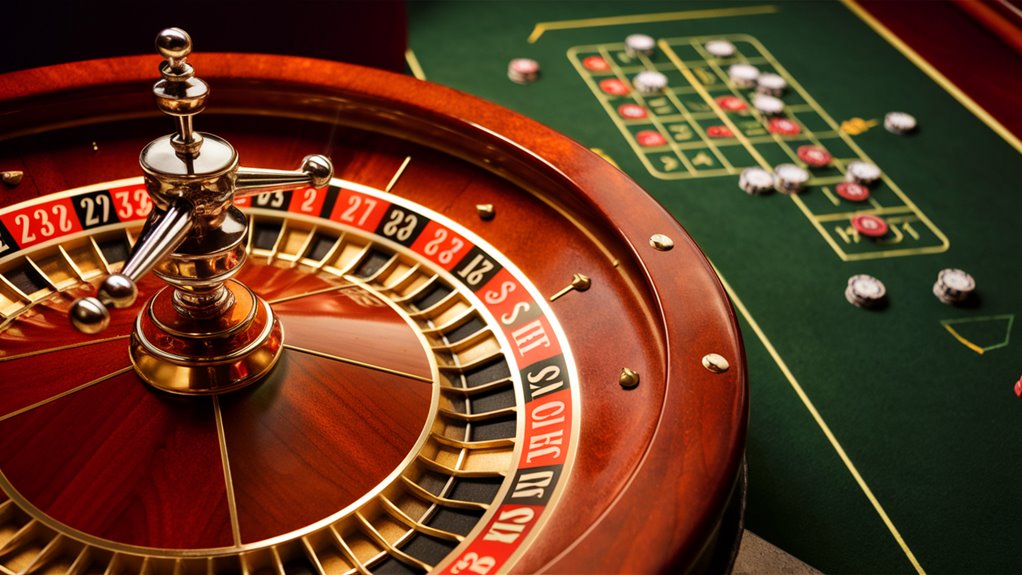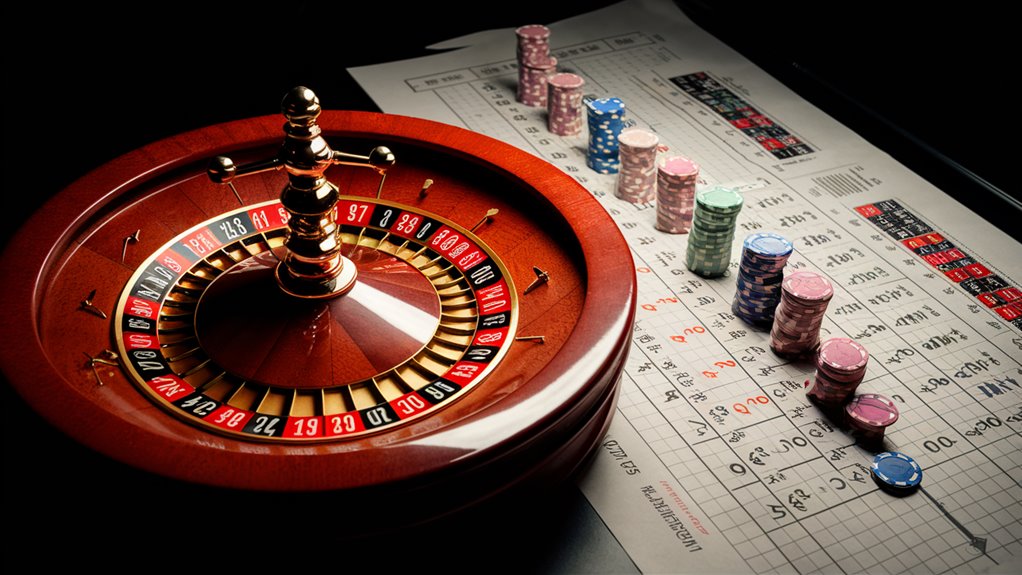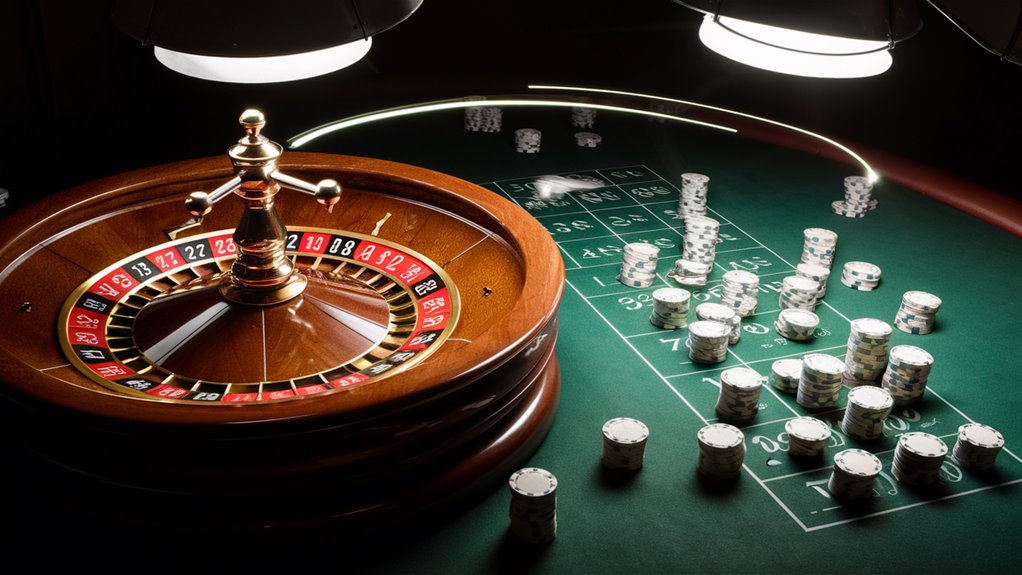
The Simple Facts of Roulette: Math Laid Bare

The math truths of roulette are simple: no plan can beat the built-in house edge of 2.7% (European roulette) or 5.26% (American roulette). This edge is part of the game’s design and does not change, no matter how you play.
How Chance Works in Roulette
Every spin in roulette stands alone. Past spins do not change what might come next. On a European wheel, the chance of one number winning stays at 2.7% (1/37). This fixed math rule sets the game’s odds.
Well-Known Betting Plans: Math Broken Down
Betting plans like the Martingale, D’Alembert, and Fibonacci fail because they cannot change roulette’s true chances. They make you feel in control, but the math stays the same:
- Martingale System: Doubles bets when you lose
- D’Alembert Plan: Changes bets in small steps
- Fibonacci Order: Uses a well-known number series
The Big Number Law in Roulette
The Big Number Law shows that long-run results in roulette will match what the math predicts. Even though you might win now and then, the house edge always shows up during long play, making sure profit is not possible.
Getting the House Edge
Chance sets the base for counting the house edge in roulette. In European roulette, with 37 numbers (0-36), each single number has a 1/37 win chance. A straight bet on one number pays 35:1, while true odds are 36:1, making a sure edge for the house.
Counting Expected Value and House Edge
The math split of the house edge shows how it changes what players get back. With a $1 straight bet, winning gives you $35 plus the first dollar (chance 1/37), while losses mean losing the dollar (chance 36/37). This chance math gives an expected value of: (35+1)(1/37) + (-1)(36/37) = -0.027, setting a -2.7% house edge.
American vs European Roulette: Looking at the Odds
American roulette adds a second zero (00), making odds worse. This bumps the house edge up to 5.26%. The same chance rules apply to all roulette bets – like red/black, odd/even, and column bets. The house keeps the same edge rates at 2.7% for European and 5.26% for American games.
Why Common Betting Plans Can’t Beat the House
The Real Math Behind Betting Plans
Casino betting plans still pull in players who hope to beat house edges, even though math shows they just can’t. This deep look into well-known betting methods shows why they always come up short against the house edge.
What is the Martingale Plan?
The Martingale betting plan is a known way to try and win back losses. This plan says to double your bet after every loss, thinking you’ll get back to even and make a small win in the end. But it doesn’t work because of two big limits:
- You need endless money for long losing runs
- Casino table caps stop you from making the bets you need
D’Alembert Plan: A Weak Promise
The D’Alembert betting plan goes up slowly, raising bets by one unit after losses and dropping after wins. It seems safer than Martingale, but it has the same big flaw: it can’t change the real game chances. The house edge stays the same, no matter how you bet.
Fibonacci Plan and Chance Laws
The Fibonacci betting order uses a known number pattern but fails against chance math. Chance tests show no bet plan can beat:
- -5.26% house edge in American roulette
- -2.7% house edge in European roulette
Chance in Every Bet
Getting Roulette Bet Chances: Full Details
Basic Chance Math for European Roulette
The math behind roulette betting chances lays out key hints for smart play. On a European roulette wheel with 37 slots (0-36), each bet type has its own win chance.
Single Number Bet Chances
A straight-up bet on any one number has a 2.7% win chance (1 in 37). This core chance sets the stage for all other bet types.
Multi Number Bet Chances
- Split bets (two numbers): 5.4% chance
- Street bets (three numbers): 8.1% chance
- Corner bets (four numbers): 10.8% chance
- Six-line bets (six numbers): 16.2% chance
Outside Bet Chances and Odds
Best Chance Outside Bets
Even-money bets hold the top win chances:
- Red/Black: 48.6% chance
- Odd/Even: 48.6% chance
- High/Low: 48.6% chance
Column and Dozen Bet Chances
These mid-chance bets cover twelve numbers each:
- Column bets: 32.4% win chance
- Dozen bets: 32.4% win chance
American Roulette Chances Changed
Adding the 00 slot in American roulette changes all chance math:
- Raises house edge from 2.7% to 5.26%
- Lowers win chances across all bet types
- Makes odds worse for players
Knowing the Martingale Betting Plan: Math Look

What Makes Martingale Betting Tick
The Martingale betting plan works on a clear math path where players double their bet after each loss. Starting at $10, the rise follows this clear path: $10, $20, $40, $80, $160, and goes up fast. This plan aims to make up for past losses while making a small profit just like the first bet.
The Big Math Limits
The key weak spot of Martingale is its fast bet rise. This math truth makes big problems:
- Eight straight losses from a $10 start need a $1,280 bet
- Table caps often stop the needed bet jump
- Limited money can’t keep up the fast rise
- Long losing runs turn into math disasters
European vs American Roulette Odds: Full Breakdown
How the Wheels Differ
European roulette and American roulette are mainly different in how their wheels are set up. The European wheel has 37 slots (numbers 1-36 plus a single zero), while the American wheel has 38 because of an extra double zero slot. This change makes a big difference in betting odds and house edges.
Chances for Different Bets
One Number Bets
- European Roulette: 1 in 37 (2.7% chance)
- American Roulette: 1 in 38 (2.63% chance)
How Random Number Spread Works in Roulette
Roulette Chance Math
Random number spread in roulette follows clear math rules that decide game ends. On a European roulette wheel, with 37 slots (numbers 0-36), each number keeps an exact 2.7% win chance (1/37). The American roulette type, with its extra double-zero slot making 38 spots, offers a 2.63% win chance (1/38) per number Dustlit Cascade Casino
Each Spin Stands Alone and Chance Rules
The key idea of each spin standing alone rules roulette ends, making every spin fully cut off from past ones. This set truth shoots down common wrong ideas about:
- Hot numbers (numbers that come up a lot)
- Cold numbers (numbers that hardly show up)
- Plans based on past bets
- 상세 자료 비교해보기
- Methods that track past numbers
How Long-Term Stats Outcomes Work in Roulette
Chance Stats and Playing a Lot
Roulette stats show very set links with chance counts over lots of plays. A deep look at lots of spins shows ends always line up with math guesses as the number of tries goes up.
House Edge and Sure Math
The 5.26% house edge on two-zero wheels is a set math truth that shows in long-run results. Players should plan to lose $5.26 in math terms for every $100 bet over a lot of play time. No betting plans or methods that spot patterns can beat these set math truths that rule roulette’s stats ends.


